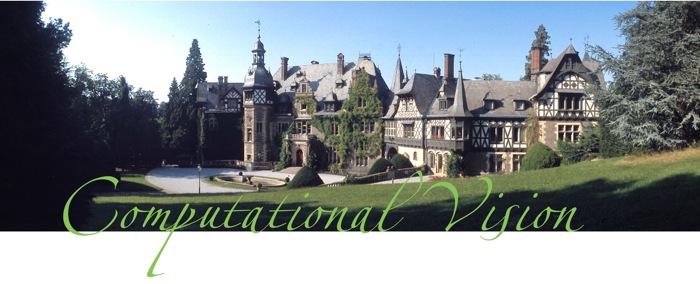|
||||||
|
||||||
|
Funded by the European Initial Training Network CODDE
Preliminary program:
|
||||||||||||||||||||||||||||||||||||||||||||||||||||||||||||||||||||||||||||
Speakers:Marty Banks, Berkeley, works on different aspects of depth perception including stereo vision and picture perception. He made important contributions to the study of spatial vision in infants and is an expert on multimodal interactions. Rob van Beers, Amsterdam, works on human motor control, especially arm and eye movements, and the processing of sensory information required for motor control. He uses a probabilistic approach, which relates issues such as motor learning, multisensory integration and movement variability to noise and uncertainty in the sensory and motor systems. Mathias Bethge, Tübingen, develops quantitative models and unsupervised learning algorithms for natural image statistics and for visual inference problems such as shape from orientation or depth from stereo. In addition, he works on probabilistic models for populations of spiking neurons that can be fit to data and are useful for analyzing distributed neural information processing. Gustavo Deco, Barcelona, works on the large-scale architecture of visual perception, attention and memory. He uses neurodynamic modeling of interacting neural populations to account for a wide range of behavioural, single-unit, and functional imaging data (modeling). Sophie Deneve, Paris, focusses on studying and modeling how the brain performs Bayesian inference tasks in very different neural systems for perception and action (basic vision, multisensory integration, motor control). The levels of analysis range from single neurons to small circuits, large populations and networks of areas. Bill Geisler, Austin has broad interests within the general areas of visual perception, such as perceptual grouping, visual search, natural scene statistics, and the neurophysiology of primary visual cortex. Anya Hurlbert, Newcastle, works on colour constancy. However, using psychophysics, computational modeling, EEG and MEG she works on a broad range of topics including perceptual learning, auditory-visual interactions, shape perception and image segmentation . Konrad Körding, Chicago, uses theory as well as computational and neural modeling to understand how information is processed in the nervous system, explaining data obtained in electrophysiology and psychophysics. This research is focused on but not limited to the economics of movements. Larry Maloney, New York University , works on models of human performance based on mathematical statistics, physics and mathematics. Pascal Mamassian, Paris, works on on mid-level vision, the link between the processing of elementary features in the image and the awareness of natural scenes. This includes three-dimensional perception, cross-modal perception, temporal dynamics of perception, and probabilistic modelling of perception. Tony Movshon, New York, studies the function and development of the primate visual system, particularly the neurophysiological basis of motion perception (electrophysiology, psychophysics) Dario Ringach, Los Angeles, works on models of cortical function and psychophysics of eye movements and sensorimotor integration. Eero Simoncelli, New York, works on statistical properties of natural scenes, the analysis and representation of visual motion (e.g. optic flow), and image processing in general (e.g. feature detection) in human and computer vision. Beau Watson, Moffett Field, works on computational models of human visual motion sensing, and technology for perceptual optimization of digital image compression technologies. Li Zhaoping, London, works on computational vision, especially pre-attentive vision, visual attention, signal processing, sensory (visual) coding, visual and olfactory object recognition and segmentation. |






